Serena Williams is Sports Illustrated's 2015 Sportsperson of the Year

This story appears in the Dec. 21, 2015, issue of Sports Illustrated. To subscribe, click here.
Real life? For Serena Williams that’s the easy part now. That’s how it works when you zoom—beyond tennis, beyond $74 million in prize money, beyond one of the greatest late-career runs in sports history—into celebrity hyperspace. That’s how it is when each “Come on!” is taken as a war cry by everyone from “Lean in” women to age-defying codgers to body-shamed kids to #BlackLivesMatter protesters to, yes, the voices of racial conciliation. The outside world accommodates. Real life does you favors.
Indeed, in 2015 Williams hit this rare sweet spot, a pinch-me patch where the exotic became the norm. She danced with Donald Trump on New Year’s Eve. She spent a night telling bedtime stories to the children of Facebook COO Sheryl Sandberg. Growing up, Williams had devoured every Harry Potter book, marveled at the business empires of Oprah Winfrey and Martha Stewart. Now J.K. Rowling was tweeting against a critic of Williams’s body, now Oprah was hustling to watch her at the U.S. Open, now Stewart was calling Williams “the most powerful woman I know.” President Barack Obama, the most scrutinized man alive, told her how great it was to watch her.
Even Williams’s most dubious moves paid off. In July, just as her drive for tennis’s first Grand Slam in 27 years hit the bell lap, she appeared in Pixels, a comedic bomb in which she anticipated a Lincoln Bedroom sex sandwich with Stewart and Peter Dinklage. Yet she escaped critical savaging, and, oh, the movie grossed $243 million. Williams’s November decision to chase down a cellphone thief in San Francisco seemed equally foolhardy—until, that is, the guy gave her phone back. Meekly.
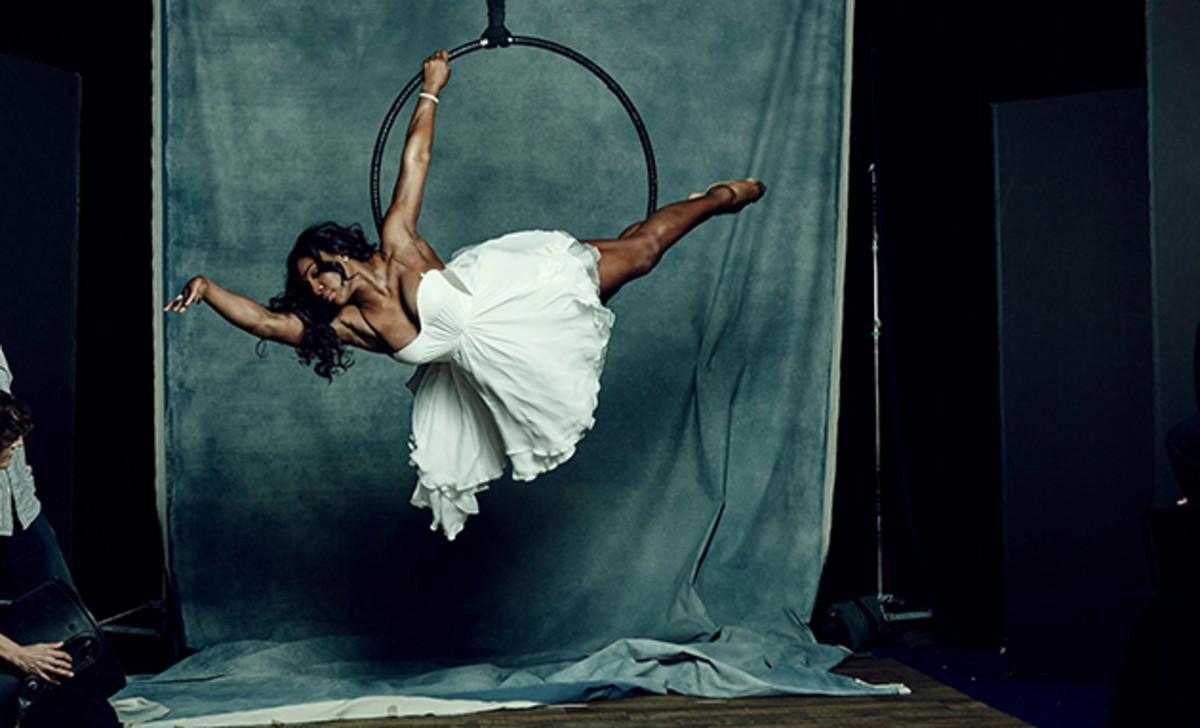
No, this year only the game gave Williams trouble. Only the 78-by-36-foot confines of a tennis court, be it blue asphalt or red clay or green grass, produced the kind of pushback that no amount of money or fame can overcome. If the real world felt like one A-list club after another, eagerly waving Williams in, tennis was the world’s most annoying bouncer, forever checking her ID. Tennis made her desperate. Then it made her hurt.
The results, of course, hardly imply that: Williams, 34, won three major titles, went 53–3 and provided at least one new measure of her tyrannical three-year reign at No. 1. For six weeks this summer—and for the first time in the 40-year history of the WTA rankings—Williams amassed twice as many ranking points as the world No. 2; at one point that gap grew larger than the one between No. 2 and No. 1,000. Williams’s 21 career Grand Slam singles titles are just one short of Steffi Graf’s Open-era record. Such numbers are reason enough for Sports Illustrated to name Serena Williams its 2015 Sportsperson of the Year.
But the numbers lie. Her tennis year was all internal discord and quelled revolts; Williams battled her body like never before. A cough and cold had her vomiting before and, for the first time, during a match: the Australian Open final, in January, which she won anyway. Bone bruises in both knees, the residue of 20 years of pounding, flared during the spring hardcourt swing and never subsided. Her focus frayed, her footwork suffering, she arrived at the French Open nursing a right elbow strain that would plague her unparalleled serve the rest of the year. The whole Serena Williams construct—intimidation, power, will—had gone oddly fragile.
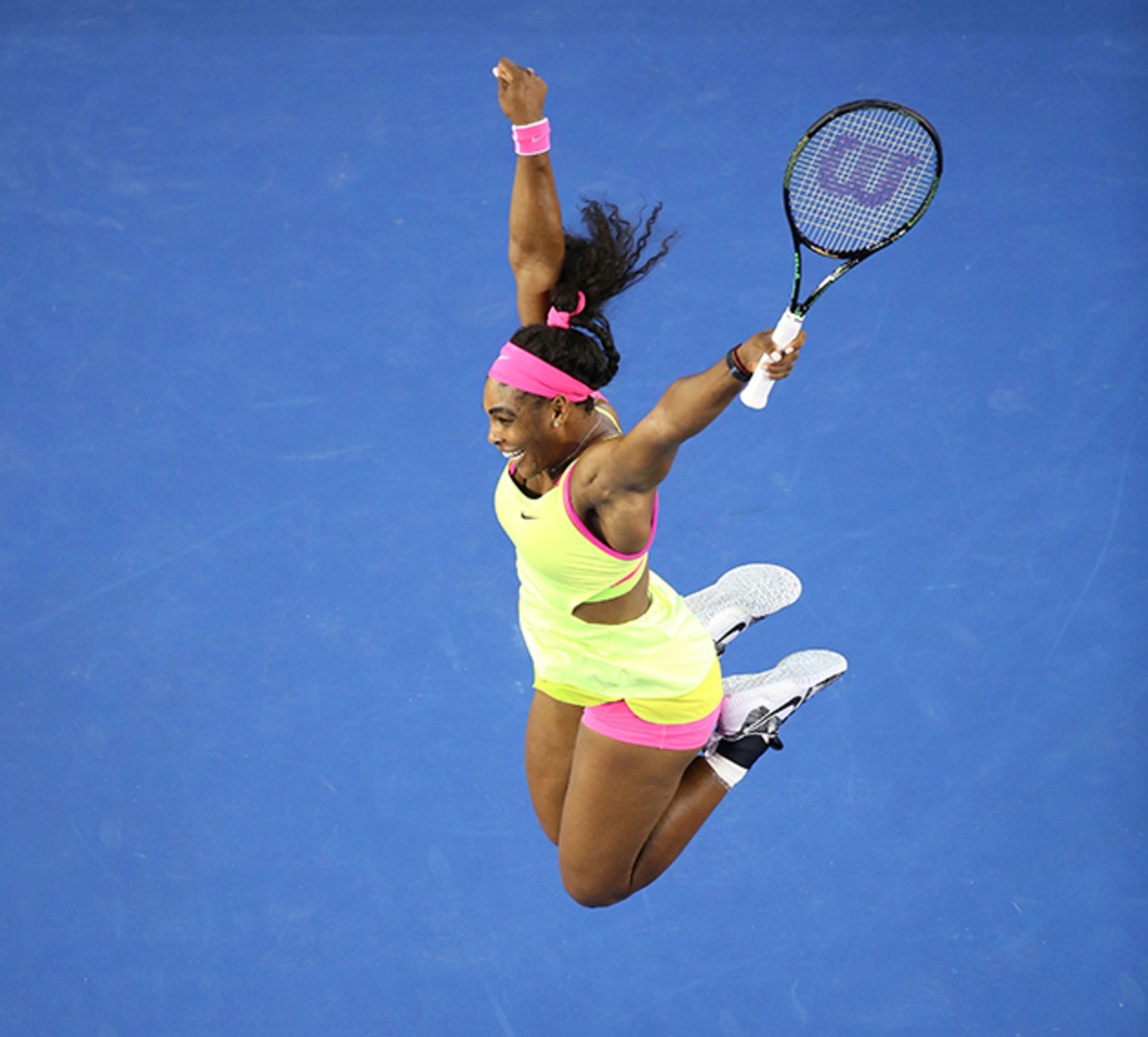
But she refused to buckle. Then, after gutting through three three-set matches in the first week at Roland Garros, including a third-round comeback over perhaps her toughest contemporary, Victoria Azarenka, Williams came down with the flu. Beset by chills, 101º fever and congestion, she could barely move, much less sprint after balls. Yet down a set and a break in the semifinal, Williams roused herself—from pitiful to pitiless—and won 10 straight games to crush Timea Bacsinszky 6–0 in the third.
At times, then, it became almost easy to forget Williams’s ailments, to marvel not just at her relentlessly lethal strokes and serve but also at the pure physicality that has pushed the women’s game to a level unforeseen by Graf and certainly by Margaret Court, who holds the Grand Slam record of 24 singles titles. But after that French semifinal Williams’s family found her curled up on a bench in the locker room, covered in towels and sobbing. Roland Garros was the 59th Grand Slam event of her career; her mother had never seen her so physically shattered with a major singles final looming. “It was heartbreaking,” says Oracene Price.
“I was crying so hard,” Serena says. “I didn’t want to win. I just wanted to go home. I said, ‘I can’t play anymore.’ ”
Twenty-four hours later Williams, unable to take flu medicine for fear of failing a drug test, was still shivering. She went to bed sure that she would have to pull out of the final. She woke up on championship Saturday and called the tournament referee to warn that she might withdraw. “If I’d had a 101º fever, I’d default,” says Chris Evert, winner of 18 majors. “But she’s just different from everybody else.”
Why Serena Williams is SI's 2015 Sportsperson of the Year
By 10 a.m. Williams, still feverish, was hitting on a practice court. By 11 she had decided to play that afternoon. Get on and off fast, she told herself. But No. 13 Lucie Safarova—and Williams’s wayward serve—pushed the final to a third set, and the effort of wrenching it away 6–2 left Williams spent. “After it was all finished? She had nothing,” says her older sister Isha Price. “It took her another week to get O.K. It was a victorious moment, but it was really scary. Because it was, like, Not again. What the hell?”
Exactly the thought of the other women on tour. The following month Williams, aching but no longer ill, danced through the raindrops at Wimbledon, surmounting a two-break third-set hole against Heather Watson in the third round (“I was on my way out,” Williams says), dodging Azarenka over three sets in the quarters and bludgeoning Maria Sharapova, soon to be the No. 2 player in the world, in the semis and rising star Garbiñe Muguruza in the final. For the second time in her career, Williams had won four straight majors over two seasons: the Serena Slam. Now the oldest woman in the Open era to win a major singles title, she was ranging the tennis landscape like some sci-fi force cooked up by James Cameron and Nick Bollettieri: wounded, hunted yet adapting to every new adversary.
All year Williams kept coming, on a path more arduous than anyone knew, and she put together the best season by a woman in a quarter century. “I do want to be known as the greatest ever,” she says. To many she already is. But that’s not the sole reason why we arrive, now, at this honor. It’s also because Williams kept pushing herself to grow, to be better, and tennis was the least of it. The trying is what’s impressive. The trying is why we are here.
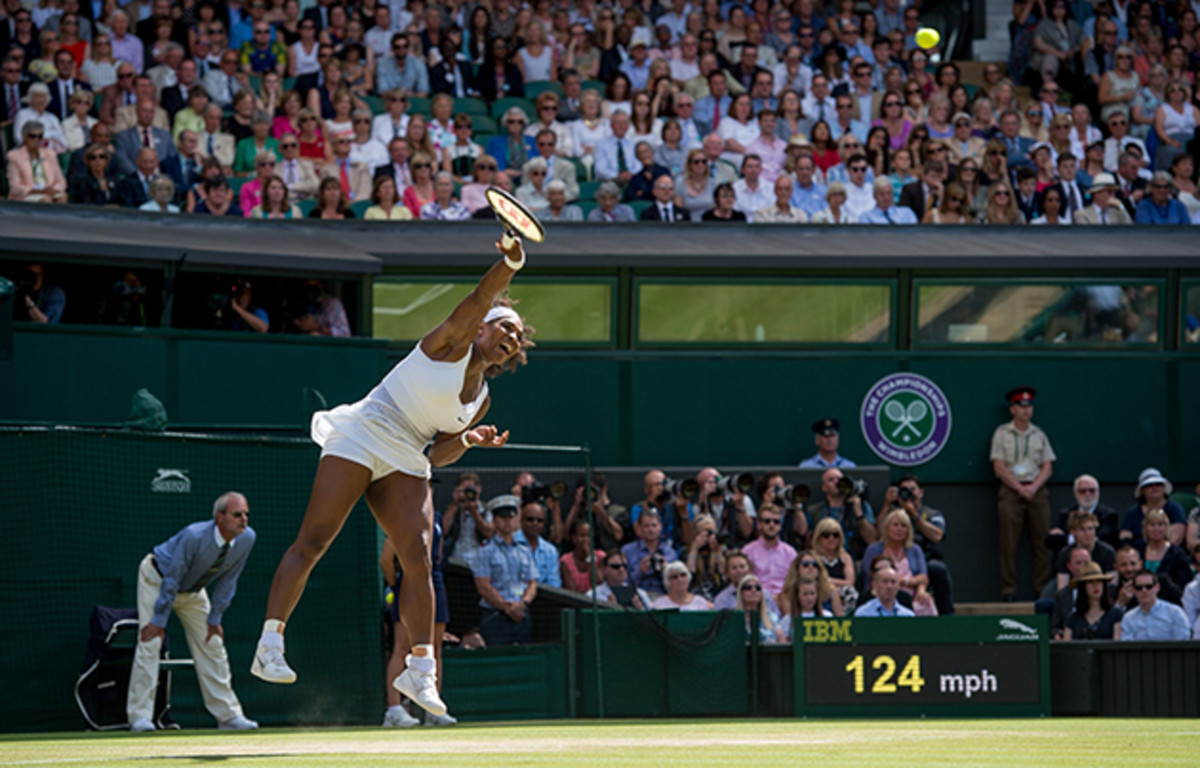
The first hint that this might be a different Serena Williams in 2015 came in Melbourne, during the Australian Open final. Blasting 18 aces and sharp off the ground, she produced perhaps her cleanest performance of the year, yet Sharapova still made her labor. Serving at 3–all, game point, in the second set, Williams cracked a seeming service winner and screamed “Come on!” even as Sharapova blocked the ball back. The chair umpire called hindrance. She docked Williams a point.
The last time she received such a penalty, in the 2011 U.S. Open final, Williams lambasted the official (“Are you the one who screwed me over last time here? . . . Don’t look at me. . . . If you ever see me walking down the hall, look the other way”), lost focus and lost the match. She had also lost two years earlier when, on match point in the U.S. Open semis, she infamously threatened a line judge over a foot-fault call, incurring a record $82,500 fine. This time? Williams wiped her face and, two points later, ripped a forehand winner. She celebrated with a slow fist pump and a sardonically soft “Come on.” Then she fired another ace.
“I just kind of laughed,” Williams says. “A few years ago I wouldn’t have been able to laugh. I haven’t lost that part of me; I’m very passionate on the court, but I’ve learned to be fierce more on the inside. It was a Grand Slam final. I said, ‘Serena, just laugh. You’ve been here before.’ I learned from that experience.”
No one suggests that Serena has evolved into the sport’s ambassador of peace and quiet. Her fans love her combustible displays as much as her detractors loathe them, and between Williams’s spray of f-bombs in the 2015 French Open final and her screaming, “Yes, bitch! Yes!” after blasting a winner during this year’s U.S. Open semis, both camps can rest assured that her core remains molten. “I’ve seen some growth,” her mother says, laughing. “I’ve seen some maturity . . . maybe 10% more.”
For those who think that’s hardly enough to justify an award that for 60 years has emphasized an athlete’s “manner,” consider the fact that profanity never disqualified a male candidate (cough, Tiger Woods), that microphone technology has improved greatly over the decades and that the only safe pick might be a champion like American Pharoah (page 144), who may well be cursing in a language you don’t know. Besides, taken in the long continuum of tennis bratitude, 10% is no small amount. Since joining forces with coach Patrick Mouratoglou in June 2012, Williams has been calmer, more circumspect with officials and more gracious to her opponents. And, this year, she brushed aside justifiable rage and fear of public humiliation—not to mention a point of family honor—to address the darkest chapter of her career.
That was the second sign of a new Serena Williams. Four days after winning Australia she announced in Time that she would return to Indian Wells, a premier tour stop in California where, in 2001, unfounded rumors of a Williams family match fix sparked unprecedented ugliness. When Venus Williams, who had pulled out of her semifinal against Serena with a knee injury, appeared in the stadium with her father, Richard, for the final between her younger sister and Kim Clijsters, vicious booing ensued. Richard later claimed that he heard racial slurs, and TV cameras showed him shaking his fist at the crowd.
• Celebrating Serena: A look at each of her 21 Grand Slam titles
By the time Serena, then 19, walked on the court, the crowd was in full lather—and she still hadn’t been told why. Boos changed to cheers whenever she double-faulted or made an error, but they returned when she beat Clijsters and grew thunderous when she left the court to hug her sister and dad. She would write in her 2009 autobiography, On the Line, that she, too, “heard the word, nigger, a couple times.”
No outside source confirmed hearing such language. Nor did anyone from the tournament make any mollifying announcement. “No one said anything,” Oracene says. “They were just letting it go on, almost like, She deserved this.”
“As a family we were all hurt,” says Isha. “It stayed with us a long time. Our parents have always been very clear about who we are in terms of the country, but to have evidence of that? It was a disillusionment, the end of any innocence that we had about the world we lived in.”
Trophy in hand, Williams rode the two hours home to Los Angeles in tears. She begged her parents not to make her go back to Indian Wells, and no one in the family tried to—despite 13 years of questions, the threat of fines, the lost winnings and ranking points. At best Indian Wells served as an example of hostile relations between the U.S. tennis establishment and two of its greatest stars. At worst it became the WTA Tour’s open wound, revealing simmering tensions in a sport that had long heralded itself as a pioneer in racial and sexual equality.
But a few years ago, after Mouratoglou replaced her parents as her full-time coach, Williams saw a film about Nelson Mandela and began to reconsider. She almost played Indian Wells in 2014 and backed off, but over the next year she approached her parents and three sisters, one by one, about a return in ’15. She went through three drafts of her Time essay, took one to her dad last fall and choked up trying to read it aloud. Finally she just handed it to him.
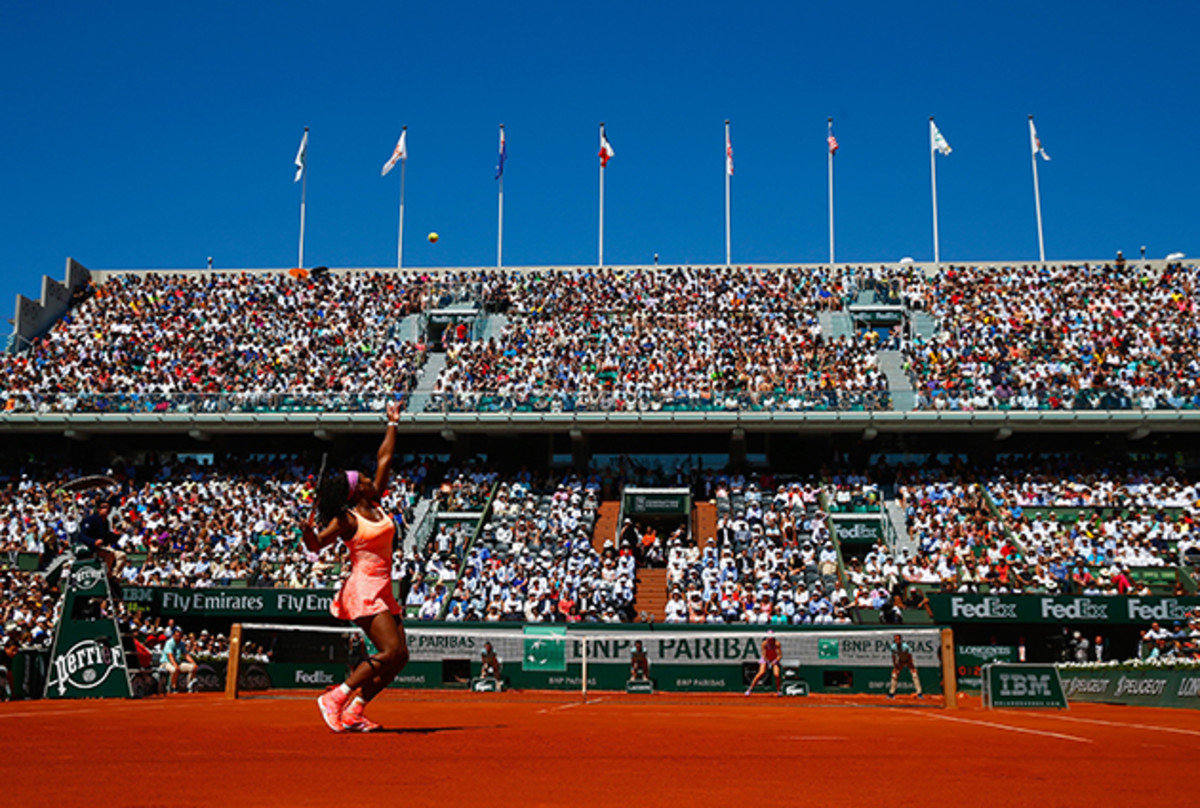
Hardly anyone in the family loved the idea. Venus and Richard weren’t ready—not yet—to accompany Serena to Indian Wells. “I wouldn’t have gone back,” Oracene says. “Not because I didn’t forgive them—because of my own integrity. If they didn’t think I deserve to be there? Then I don’t need to be there.” The fact that Indian Wells organizers invited the Williamses back every year—and that the boos had come from fans irate at not being able to see the sisters play—had nothing on the hostility that the family remembered from that day.
If just one sister or parent had outright opposed her returning, Serena says, she would have thrown the essay away. But Richard said it would be a mistake for her not to go back—and the rest chimed in, because they sensed how much Serena needed it. Part of this was simply unfinished business, the sense that Serena’s legacy had been tarred by events beyond her control. Part was her Jehovah’s Witness faith. “I was brought up to forgive people,” Serena says, “and I felt that I wasn’t doing what I was taught.”
That might have been the biggest surprise. “To learn to forgive: She has a problem with that,” Oracene says. “It’s a big step for her. Because she’s the kind of person who would get revenge on you—and it was never going to end.”
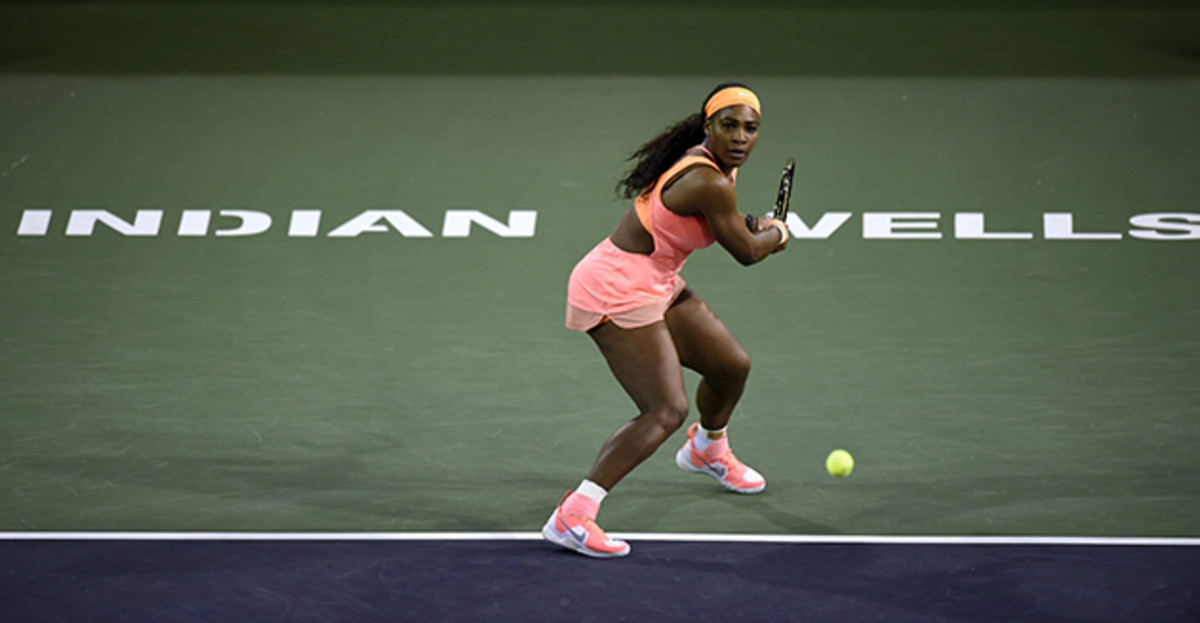
The final factor pushing Williams back to Indian Wells was more complicated. On Aug. 9, 2014, in Ferguson, Mo., an unarmed African-American 18-year-old named Michael Brown was shot six times and killed by white police officer Darren Wilson; the body lay in the street for four hours. For many the shooting highlighted, yet again, a pattern of abusive policing and the seething mistrust between white authority and black communities nationwide. It sparked protests and furious debate. When, on Nov. 24, 2014, a grand jury voted not to indict Wilson, Williams tweeted, “Shameful. What will it take???”
On Nov. 30, five St. Louis Rams players took the field in a “Hands up, don’t shoot” display reminiscent of the gloved fists of Tommie Smith and John Carlos at the 1968 Olympics. Black athletes were becoming more vocal. Williams had been slightly ahead of the curve; in 2000 she boycotted a tournament in Hilton Head, S.C., to protest the flying of the Confederate flag over the state capitol. But for a long time she had tended to view race matters with a cool, almost clinical detachment.
Here, for instance, is how she describes an incident with a young gas station cashier when she was in her early 20s: “He didn’t want to touch my hand. He told me to put the money down. I found it fascinating that it’s 2000-something and this guy had that attitude toward a black person. I wanted to do things, like, touch this or that, just to see what his reaction would be. I’m almost glad I had that experience, so I can understand more what people have to go through.”
It wasn’t until 2006, when Williams made her first trip to Africa and toured Ghana’s slave dungeons, that inequality became a more visceral concern. She revisited the continent often and financed the construction of two rural high schools in Kenya, a country where many girls drop out and marry by 14. Williams insisted that enrollment be at least 40% female. For now her schools serve 442 students, 54% of them girls. This year’s senior class at the secondary school in the village of Wee included two boys who qualified for college—a level that no student in the region had ever attained. In the U.S., meanwhile, Williams has financed four years of college education for six youths and is paying the bills for a dozen more.
Her return to Indian Wells presented a new opportunity. Williams knew that media coverage would be enormous, and Michael Brown’s age resonated with her. “I had been a teenager at Indian Wells, and that was hard for me to go through—especially when I was thinking, It’s 2001, I [shouldn’t] have to deal with that stuff as much anymore,” she says. “Now fast-forward to 2015, and we still have young black men being killed. Someone needed to do something. And I thought then that there was something greater than me and tennis. I needed to go back there and speak out against racism.”
After viewing a TED talk by Bryan Stevenson, executive director of the Equal Justice Initiative—a Montgomery, Alabama-based legal organization that provides representation for prisoners, mostly black and poor, who might have been wrongly convicted—Williams decided to pair her return to Indian Wells with an appeal for support for EJI’s work. Since 1989 the organization has saved 115 men on death row from execution. No prominent athlete had endorsed its work before. Offering up a hitting session, a souvenir racket and courtside tickets for her first match, Williams raised $100,000 for EJI; the attendant publicity generated $100,000 more in contributions.
“It’s been huge,” Stevenson says. “It’s so rare when athletes at the top of their game are willing to embrace a set of issues that, for a lot of people, are edgier. This is not aid to orphans. These are questions of racial bias and discrimination, mass incarceration, excessive punishment, abuse of the mentally ill. You don’t change the world by doing what’s comfortable or convenient. You have to be willing to do uncomfortable things. In a small way, Serena’s return to Indian Wells represented that. But associating herself with an organization like ours was more significant: She was standing when a lot of her contemporaries remain seated, speaking up when others are being quiet. That’s an act of hope and an act of courage, but it’s also an act of change.”
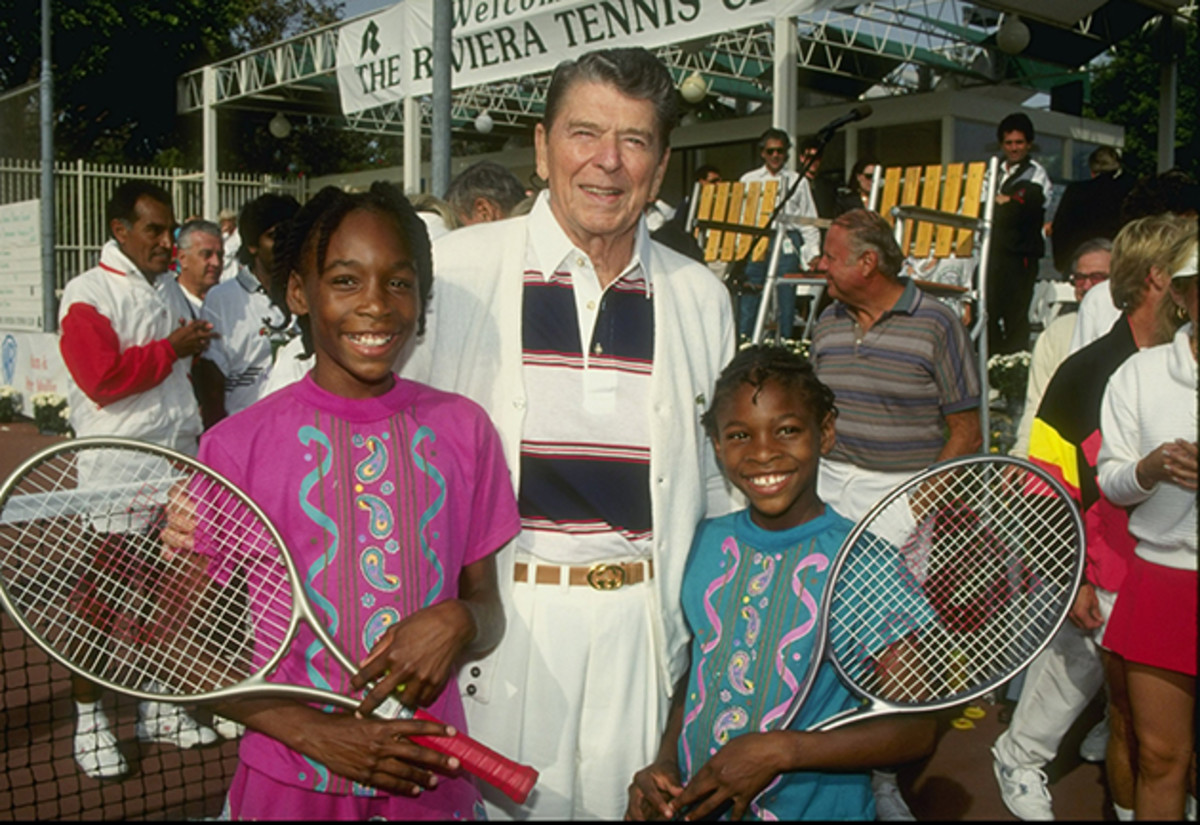
Still, by the time Indian Wells rolled around last March, Williams wasn’t feeling all that brave. Two days before her opening match, against Monica Niculescu, she had a panic attack in the bedroom of her L.A. home. I do not want to go there, Serena thought. What if it’s horrible? What if they boo again? How can I get out of this?
Isha now was all for her pulling out. “I was one of those saying, ‘You don’t know what the people are going to do; I don’t want you exposed, I don’t want to see you hurt again,’” she recalls.
But Serena pulled herself together. Venus and Richard stayed home in Florida, but Serena, accompanied by Isha, their sister Lyndrea and Oracene, drove to Indian Wells the following day. Serena was too nervous to practice there before play began and even more jittery on the golf-cart ride to the court for the Friday night opener. “A very, very scary time,” she says, “but it wasn’t about me at that point.”
She had nothing to worry about. Williams walked out to a standing ovation that lasted into her warmups. At first Oracene was wary, wondering, Why are they being so nice? But Serena’s turn to conciliation made her mother take stock. “She needed that, and I learned that I need a bit of that, too,” Oracene says. Isha started crying. When Serena pulled off her headphones before the warmup and heard the cheers, she cried too.
It was a terrible match, full of nerves. Williams, back on the court where, half a lifetime ago, she had beaten Graf to claim her first significant title, won 7–5, 7–5. The crowd stood again and cheered when Williams packed up and walked off.
“Everyone always asked, ‘What was your greatest moment in tennis?’ and I always said it hasn’t happened,” Serena says. “But I think it has happened now, and that was going back to Indian Wells and playing. It released a lot of feelings that I didn’t even know I had. I was really surprised at how emotional I got—and how relieved I felt after everything was said and done.”
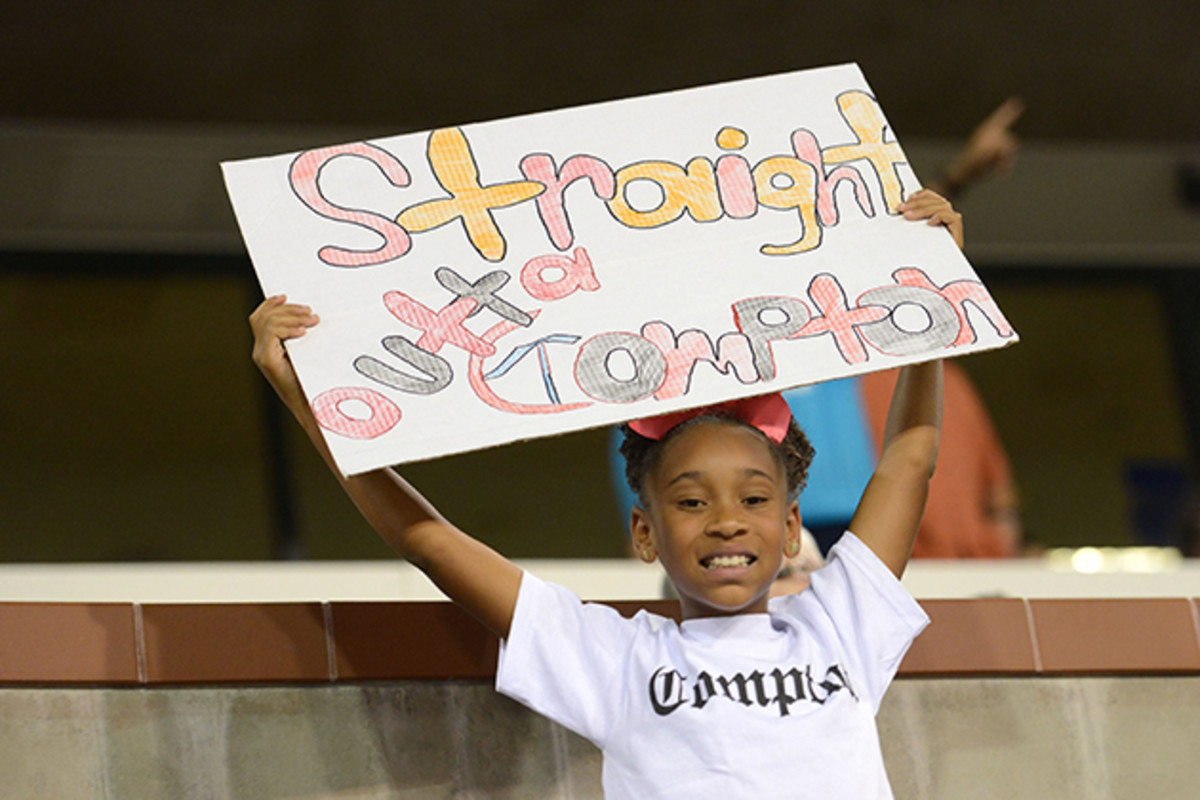
But Serena wasn’t done. None of us were. Nothing about America’s race problem got resolved in 2015; if anything, it seemed to get worse. Black people kept dying at the hands of police officers. Nine black churchgoers were massacred by a lone white gunman in Charleston, S.C. On Aug. 7, Angelo State football player Christian Taylor, unarmed and apparently high on pot and a synthetic psychedelic, drove his car through the front window of a car dealership in Arlington, Texas, and was shot and killed by a police officer. Serena tweeted, “Really??????!!!!!!!!!!? are we all sleeping and this is one gigantic bad nightmare?” (The officer was subsequently fired for “exercising poor judgment.”)
It’s an old saw that a nation gets the president it deserves. Maybe the same goes for its champions. No other active U.S. athlete rules a sport the way Serena Williams rules hers, and few reflect our era better. Is she polarizing? Has she, at times, been her own worst enemy? Well, we are an angry country now, disdainful of consensus, with hard divides between right and left, black and white, rich and poor, immigrant and native, millennial and boomer. But the promise of opportunity remains, and who embodies it better than the poor black girl who rose from the streets of Compton, Calif., to high tea at Wimbledon—accompanied by a sibling nearly her athletic equal?
Yet in a time of confrontation it’s perhaps more striking that Williams, the ultimate with-me-or-against-me player, proffered an open hand. Far past the time that anyone expected it, she demonstrated a capacity for change—innovation, if you will. Like many, she’s groping for answers. In September she enrolled in an online history of civil rights class at the University of Massachusetts. “I was disappointed in how little I knew,” she says, “compared to how much I thought I knew.”
But she’s determined to make a difference. In October, Williams guest-edited Wired magazine, which published her essay urging Silicon Valley to hire more women and minorities. “To those of you involved in equality movements like Black Lives Matter,” she wrote, “I say this: Keep it up. Don’t let those trolls stop you.” In November she gave a Q&A before 1,200 students and faculty at the University of Pennsylvania and said she felt cowed by the example set by black activists of the 1960s.
“I’ve been a little more vocal,” Williams said, “but I want to do more. I want to help everyone to see the so-called light. But there are a lot of other athletes, actors, politicians who are speaking out—of all colors, by the way. They’re not sitting back. They’re calling for justice straight away. It makes me look at myself and say, like, What am I doing? I have a platform. I can speak out, too. If one person hears me, maybe that person can speak out and help. I embrace that. I’m willing and happy to be part of this new movement.”
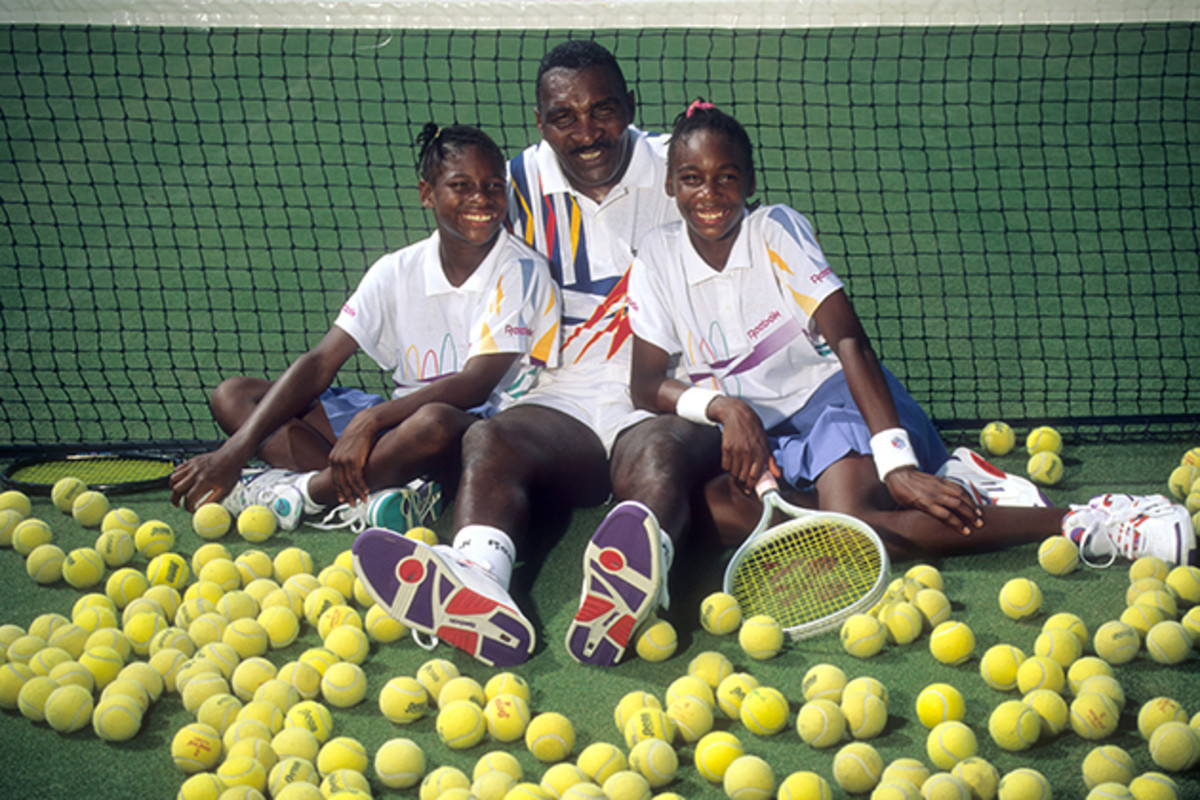
But let’s be careful, now. All this talk about race makes it easy to place Williams in an ever-narrowing box, which is never smart. She is annoyingly tough to pigeonhole. Yes, she spent her early years in gangland Compton, suffered a grievous loss there and retains one of the best urban death stares in the business. But she moved to Haines City, Fla., to attend Rick Macci’s tennis academy when she was nine, and she loves suburban staples such as The Golden Girls and Green Day. She lacks her parents’ first-hand recall of white only water fountains. The Williams girls bristled when Oracene asserted that they’d never be fully accepted by whites. “They used to say, ‘You’re racist!’ ” Oracene says. “And I’d say, ‘I’m not. I just want you to be aware.’”
So Serena is trying, all right, but it’s vital to note that her college civil rights course is an elective. Her required course is Kinesiology 100; the former business major is now premed, she says, taking online undergraduate courses through UMass and looking to focus on “nutrition, holistic medicine and healing naturally.” Day to day, identity politics battles for attention with family, tennis, her clothing line and an unlikely galaxy of people spinning in and out of her orbit.
“Like all women, Serena is interested in making a beautiful home,” says Martha Stewart, one of her companions at the New Year’s Eve bash at Trump’s exclusive Palm Beach club, Mar-a-Lago. “She’s asked me lots of questions. She likes to hang out with success. She likes to hang out with people who are not going to pander. Yet she also can be very kittenish, can get real pouty and babyish and seem like a juvenile even though she’s not. That’s her charm. And it’s not fake.”
The entourage? Williams’s coach is French of Greek extraction, her female agent and live-in bodyman are white Americans and the 64-year-old guy who is her fitness trainer is also white. Until this year Williams’s physio was an American-Korean-Canadian, and her hitting partner, as close as a brother, was a Serb-German. Her romantic history involves a mix of white and black men; recent rumors have Williams bouncing between the rapper Drake and 32-year-old Reddit cofounder Alexis Ohanian. Good luck nailing down her type.
“I hear I’m with someone new every week,” Williams says, confirming none of it. “I’m really happy right now.” It’s early November, a Monday evening. She’s sitting in her breakfast nook in Bel Air, eating an indeterminate bowl of takeout. Could be Chick-fil-A; Williams says she’s addicted. Otherwise she’s picky: allergic to milk, gave up red meat, hates the taste of eggs. Earlier in the day she lounged in a sawed-off fuselage on a Sunset Boulevard parking lot, filming a Nike spot. (“Yo, LeBron, let’s go to Spain and play some tennis. . . . You know your backhand sucks, right?”)
A $203,000 Aston-Martin sits in the driveway. In a few hours she’ll jet to San Francisco and her soon-to-be-viral showdown with the cellphone thief. She talks about bunking up, possibly, “at Sheryl’s.” As in Sandberg.
Serena Williams comforted Sheryl Sandberg after husband's death
They met in December 2014, after Williams read Lean In, Sandberg’s best seller about women leaders. Williams tweeted that Sandberg was the celebrity with whom she most wanted to have dinner; Sandberg reached out. Soon after, there they all were at a Florida seafood restaurant: Williams with a friend and Sandberg with her two Harvard degrees, $1.3 billion net worth and tech executive husband, Dave Goldberg. Sandberg, used to self-promoters, was struck by Williams’s curiosity. She kept asking questions. She wanted to know all about technology. “She’s incredibly smart,” Sandberg says.
Little of this, of course, hews to the image of Williams screaming on court, or the shutdown demeanor she can display in press conferences. Most tennis fans see only her extremes. “The tendency is to oversimplify black life, and she represents all of its complexity,” says Penn sociology professor Camille Charles. “People are almost surprised when Serena is sweet. That’s unfair.”
Last May, Goldberg, 47, died of head trauma after falling on a treadmill while on a family vacation in Mexico. Sandberg, now 46, was shattered. Williams was playing the Madrid Open when she heard; she posted her condolences on Facebook, but that didn’t seem enough. “I just kept getting these messages from Serena, every couple of days—for months,” Sandberg says. “Texts, messages, voice mails. She would write, ‘You have all my strength’ or ‘You are the strongest woman I know. You will get through this.’ ”
They talked often. Williams’s oldest sister, Yetunde Price, was shot to death in Compton in 2003. Williams opened up to Sandberg about her own grief, how she worked through it. She won Roland Garros, Wimbledon; the Grand Slam drumbeat began. “And they just kept coming,” Sandberg says of the messages. “For Serena Williams to say, ‘You have all my strength’? God, when you’re like where I was after Dave died, that feels like a lot of strength. I would feel like she was carrying me.”
Once she returned from Europe, Williams showed up twice at Sandberg’s Menlo Park, Calif., home. It wasn’t all gloom and grieving; they talked about dieting, Williams’s love life, goofy things her family did. More than once Williams helped Sandberg put her two children, 10 and eight, to bed, lying down and telling “incredible stories,” Sandberg says, “about her life and about trying and the times it was hard—and what she wants for them.”
In early August, just before turning out the light, Williams told the children the Indian Wells story. She spoke of the hurt she felt from the crowd. She spoke of her vow never to return. She spoke of how you try to take life’s bad things and make some good of them, to let go, to move on, the same way you try to overcome the senseless loss of a sister or husband or dad.
Did it help? With kids, you never know. “I thought the way she told it was beautiful,” Sandberg says.
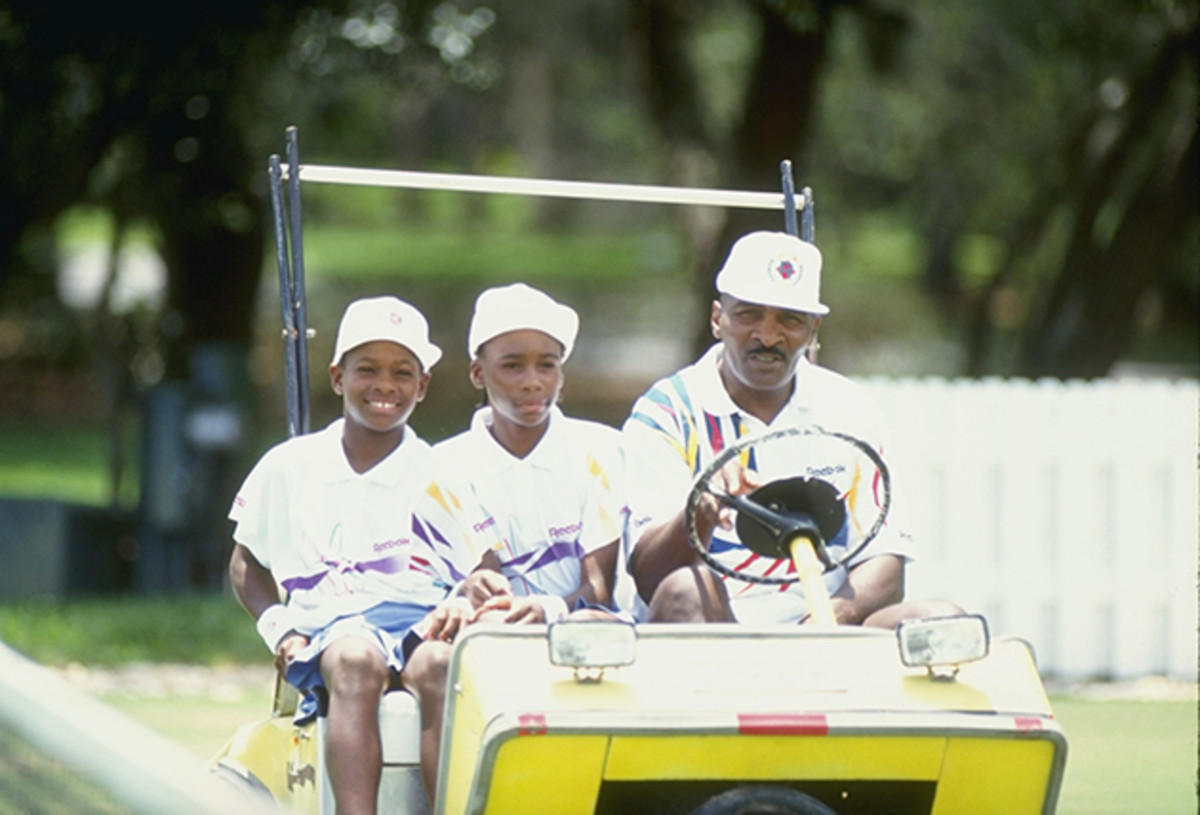
One Friday in mid-November, Williams walked with her usual near-plodding gait onto a court in the Los Angeles Tennis Center at UCLA. The other courts were empty. Students hurried past, staring at phones. It was only 9 a.m., but the sun had the court surface well heated, and Williams moved to a small patch of shade beyond the lines. She dropped her tennis bag, plopped on the ground and began to stretch.
Years ago, when Williams was in optimum shape, she used to run the 21⁄2 miles to the courts from her home in L.A. Drivers hurtling by on Sunset would do a double-take—Hey, wasn’t that. . . .?—but by then she was gone. Today, though, her hitting partner, former Ole Miss All-America Robbye Poole, picked her up in his rental. Williams hasn’t played much lately.
In early September, Williams suffered one of the biggest upsets in tennis history, losing her U.S. Open semifinal to 43rd-ranked journeywoman Roberta Vinci 2–6, 6–4, 6–4. The Grand Slam quest was dead, just when it had seemed assured: Flavia Pennetta, who like Vinci had never beaten Williams, was waiting in the final. Tennis fans, not to mention those who like tidy narratives, felt cheated. Right knee trouble in Indian Wells had forced Williams to withdraw before the semis, derailing a cathartic title run, and now history laughed at her in Flushing Meadow. Her season had everything but closure.
“I didn’t want to necessarily put a fist through a wall—I felt more like, Ah, man, I was so close!” Williams says. “I’ll always think about what I could have done better. Could I have come up on the net? Been more consistent? It’s not anger. It’s analyzing: What can I do next time?”
Yes, she admits now, the pressure got to her. But after the initial shock Williams was less devastated than exhausted. Hadn’t she won three majors? Her second Serena Slam? Meanwhile her knees and elbow were aching, bad, and the adrenaline drop had left her hollowed. So, after one day of irritation, she lost herself in promoting her fashion line for HSN at New York’s Fashion Week, then shut down her season. She didn’t touch a racket for a month. When the WTA Tour moved on to Beijing in early October, though, Williams felt something stir. In the middle of the month she put in one hard practice and sent out word on Snapchat: “I’ve got some good news and some bad news. The good news is I dreamed about tennis last night. The bad news is everybody better watch out.”

But she needed rest. Mouratoglou demanded that she stay true to her word and put the racket back down. She didn’t hit for another two weeks. Instead, her fall unrolled in a parade of real-world busyness: the speech at Penn, sponsor work, coursework, a stage chat at a Fast Company seminar in New York City. The guy responsible for James Bond’s ride in Spectre flew in from London to custom-detail Williams’s new Aston Martin; she’s been named the company’s chief sporting officer. Why? “She’s a predator,” says design director Marek Reichman. “We consider our cars predatory.”
Then there was the shoot for this week’s SI cover, a six-hour production involving a cooing crowd of handlers, makeup artists, designers, assistants, wardrobe advisers, two caterers, one aerialist for the hanging hoop thingy, a gold throne, a makeup trailer, a food tent and a supernova fashion photographer who said, “I love it!” A lot. They played Drake once or twice. Williams sang along.
But the next morning, in the quiet at UCLA, it was just Williams and Poole. She wore tights, ankle braces, a visor, no makeup. “Know your lane,” she likes to say. “My core is tennis.” Some girls peeked into the court, giggling, and yelled for a photo. Williams didn’t answer; Poole said, nicely, “Not now.” Then Williams stood at the baseline and hit her first forehand, easy, accompanied by a long, break-ending “Ohhhhhh.” The clank of heavy machinery echoed from the construction site next door. Williams hit 20 strokes, harder now, then bent over and stayed that way a good 15 seconds.
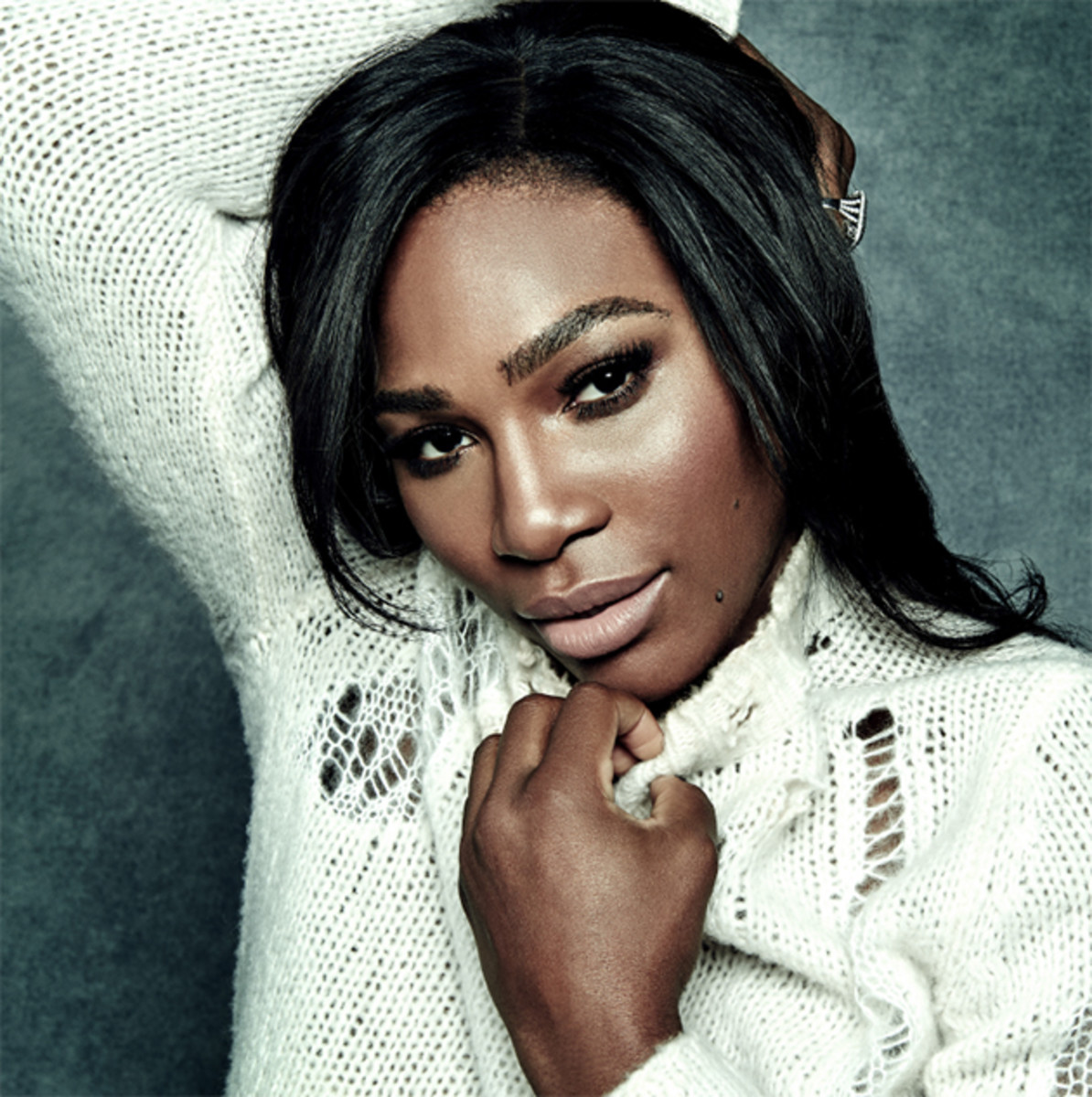
After a bit she moved forward, sliced a nifty backhand volley. Four large UCLA football players were watching; word had gone round the training table that Williams was working. She didn’t notice. She stood at the T fielding Poole’s forehands, netted a volley, brought the offending racket hand up to her face and berated it. Now Poole stood at his T, and they pelted volleys at each other, the ball never hitting the ground—14, 16, 22 straight. It looked so easy. The game makes Williams miserable, and it makes her shine.
By 9:45 she was done. Light stuff, but instructive. “Moving pretty good, and I’m not taking any Advil, not taking Voltaren,” Williams said. “The elbow feels much better; it was so bad, I could not serve. It was a disaster. But I’ve been doing this one stretch that’s been totally opening it up, clearing it out. Really good.”
As soon as she stepped off-court, her walk slowed again. Poole ran to get the car. One of the football players, a linebacker, lingered, and Williams politely said hello and asked a few questions, all while hoisting an unwieldy box of tennis balls and edging away. She knew what was coming. In seconds, teenagers were closing in from every quadrant: snapping photos, asking for selfies. She managed to be warm and cool at the same time, to stop and keep going. But when she reached the sidewalk outside the gate, Poole wasn’t there.
A woman, 18 maybe, appeared at her elbow. “Serenanicetomeetyou,” she began, then had no idea what to do next. Photo? Autograph? Hug? “Oh,” the woman said, and then turned and raced away. Williams cocked an eyebrow, shifted a hip. The box of balls was getting heavy, but she didn’t seem to mind. Standing in the sun on a street corner, unrecognized at last, she seemed to exhale—to settle—in a way that she couldn’t on stage or film set or camera. Poole rolled up, his little silver Nissan covered in dust. She couldn’t help but grin.
“This is it,” Serena Williams said. “This is my life.”
